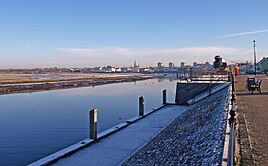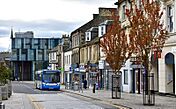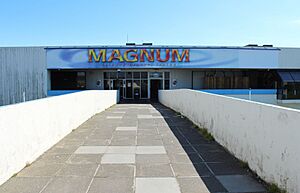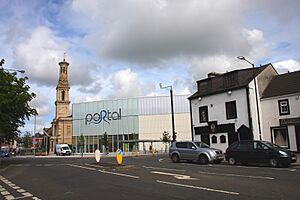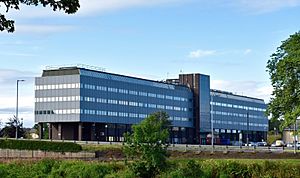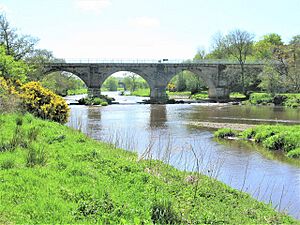Irvine, North Ayrshire facts for kids
Quick facts for kids Irvine
|
|
|---|---|
| Administrative centre and new town | |
|
|
|
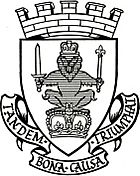 Coat of Arms of Irvine |
|
| Population | 34,130 (2020) |
| OS grid reference | NS325395 |
| • Edinburgh | 77.7 mi |
| • London | 430.9 mi |
| Council area | |
| Lieutenancy area |
|
| Country | Scotland |
| Sovereign state | United Kingdom |
| Post town | IRVINE |
| Postcode district | KA11 – KA12 |
| Dialling code | 01294 |
| Police | Strathclyde |
| Fire | Strathclyde |
| Ambulance | Scottish |
| EU Parliament | Scotland |
| UK Parliament |
|
| Scottish Parliament |
|
Irvine is a town located on the coast of the Firth of Clyde in North Ayrshire, Scotland. In 2011, about 33,698 people lived here. This makes Irvine the largest town in North Ayrshire and the 22nd largest in Scotland.
Irvine was chosen as Scotland's fifth and final "new town" in 1966. A new town is a planned community built to help with population growth. Irvine is also the main office for the North Ayrshire Council, with its headquarters at Cunninghame House.
Long ago, in the 12th century, Irvine was an important military center for Scotland. It was also one of Scotland's early capitals under kings like David I, Robert II, and Robert III. The famous Scottish poet Robert Burns once lived and worked in Irvine. Two streets in town are named after him. There's also a yearly festival called Marymass, which celebrates Mary, Queen of Scots, who some say visited Seagate Castle.
Contents
What Does the Name Irvine Mean?
The name Irvine might mean 'green river'. Over time, its spelling has changed many times. Some old spellings include Irwyn, Ervin, and Irewin. Another idea is that it means 'west flowing river'. The name "Eriwine" or "Erwinne" are also old English first names.
Irvine's Long History
Ancient Times in Irvine
Some parts of modern Irvine, like the village of Dreghorn, have been lived in for a very long time. Archaeologists have found signs of people living there since the Stone Age. There are also old Iron Age forts around Dreghorn.
The Grannie stone is a large boulder in Irvine. It's either a rock left behind by glaciers from the Ice Age or the last stone from an ancient stone circle. People saved it from being blasted away when a weir (a small dam) was built in 1895. You can see the Grannie Stone when the water level is low.
Irvine in the Middle Ages
In medieval times, Irvine was a very important area in Scotland. It was once the military headquarters for the Lord High Constable of Scotland. It even served as a main base for three Scottish kings!

In 1296, during the Scottish Wars of Independence, an English army came to Irvine. They expected to fight the Scottish army, but the Scottish leaders were arguing so much that many of them joined the English king, King Edward I.
Some historians believe Irvine might have been a "Lost Medieval Capital" of Scotland. They think it could be the legendary city of Evonium, where the famous Stone of Destiny was kept before it moved to Scone. This shows how important Irvine was in the Middle Ages.
In 1618, two people, John Stewart and Margaret Barclay, were accused of witchcraft. They were said to have sunk a ship. Margaret Barclay was found guilty and executed.
Trindlemoss Loch: A Drained Lake
There used to be a large lake in Irvine called Trindlemoss Loch. It was a natural lake formed by glaciers. Over time, the lake was slowly drained. By 1691, it was completely gone. The land where the lake once was is now playing fields.
Irvine Harbour: A Busy Port
Irvine's harbour has a long and interesting history. It was once one of the most important ports in Scotland, after Glasgow. In the 19th century, other ports like Greenock became more popular, and Irvine's harbour became less busy.
Even so, ships still used the harbour, especially for the Nobel Explosives factory. This factory had its own dock, which you can still see today. A shipyard in Irvine, the Ayrshire Dockyard Company, built ships until just before World War II. After the war, it helped fix ships and made parts for famous ships like the Queen Elizabeth 2.
Today, Irvine Harbour is no longer a commercial port. It's now home to private boats and part of the Scottish Maritime Museum. You can see many old ships there, including the 'Spartan', a type of boat called a Clyde puffer.
There's a special building at the harbour that used to show the tide level. It was built in 1906 and used a ball and pulley system during the day and lamps at night. This building is now being restored by a group called Coastwatch Scotland to be a watch tower.
The harbour area used to have a lot of industrial waste, including a pile of blue waste called 'The Blue Billy'. During World War II, a watchtower here spotted Rudolf Hess's plane in 1941.
Irvine as a New Town
In 1966, Irvine was officially named the fifth and last "new town" in Scotland. Unlike other new towns that were built from scratch, Irvine was already a large town. It had been a Royal Burgh (a special type of town) since 1372.
A group called the Irvine Development Corporation (IDC) was set up to plan and build the new town. This led to big changes in Irvine. The IDC finished its work in 1996, and the local council took back control of planning.
Since 2006, the Irvine Bay Regeneration Company has been working to improve Irvine and nearby towns. They are redeveloping Irvine Harbour to create a nice living area. There are also plans for a new golf course and hotel.
How Irvine is Governed
Irvine received its first special town charter around 1249. This allowed the town to manage its own affairs with a Town Council. In 1372, Irvine was given "Royal Burgh" status by King Robert II. This gave it special rights to control trade in the area.
For a long time, Irvine managed itself with a Provost (like a mayor) and other officials. Their offices were in the Irvine Townhouse. In 1975, the Royal Burgh of Irvine Town Council was replaced. Its jobs were taken over by larger councils, and since 1996, North Ayrshire Council has been in charge. You can find many old records from the Royal Burgh in Irvine Townhouse.
Irvine has a Community council that helps local people have a say in town matters. The motto on Irvine's coat of arms is 'Tandem Bona Causa Triumphat', which means "The Good Cause Triumphs in the end".
Irvine is part of the Central Ayrshire area for the UK Parliament. The current Member of Parliament (MP) is Alan Gemmell. For the Scottish Parliament, Irvine is in the Cunninghame South area. The Member of the Scottish Parliament (MSP) is Ruth Maguire.
In the 2014 Scottish independence vote, Irvine voted for Scotland to become an independent country, which was different from the overall national result.
Irvine's Location and Weather

Irvine is located in a flat area of Ayrshire, looking out over Irvine Bay and the Firth of Clyde. It's a coastal town, about 25 miles southwest of Glasgow. Two rivers flow through the area: the River Irvine and the Annick Water. The Annick Water is a popular spot for fishing.
The weather in Irvine usually has cool, wet summers and cold, wet winters. Snow can happen, and sometimes it brings the area to a stop, like in 1995. Because it's by the sea, the temperatures are milder than inland areas. It rains a lot throughout the year due to weather systems coming from the Atlantic Ocean.
Nearby villages and small towns include Bourtreehill, Dreghorn, Girdle Toll, and Springside.
Getting Around Irvine
Irvine has good transport links. There's a train station that connects Irvine to places like Stranraer and Glasgow. ScotRail runs the local train services. There's also a good bus network that connects Irvine to nearby towns and Glasgow.
There are two main road bridges over the River Irvine. One of them was a temporary "Bailey bridge" design for many years and was often repaired. North Ayrshire Council replaced it with a new bridge in 2010.
Irvine is also connected by several main roads, including the A78, A71, A737, and A736, which link it to other towns and cities like Greenock, Kilmarnock, Edinburgh, and Glasgow.
Culture and Fun in Irvine
In 2000, a special exhibition called The Big Idea opened near the harbour. It was built as part of the Millennium celebrations. There was a special footbridge that could open to let boats pass. Unfortunately, The Big Idea closed in 2003 because not enough people visited.
Irvine is home to North Ayrshire's theatre and arts center, which opened in 1966. It hosts plays, live music, and art shows. The old clipper ship, City of Adelaide, was kept in a dry dock near the harbour for many years. In 2013, it began its journey to Adelaide, South Australia, to be preserved and displayed there.

Irvine has two local football teams: Irvine Victoria and Irvine Meadow. The town's rugby union team is Irvine RFC.
The Irvine New Town Trail is a path that goes around Irvine and through nearby areas. It's part of the British National Cycle Network and is great for cycling.
The Irvine Burns Club is one of the oldest clubs in the world dedicated to the poet Robert Burns. It started in 1826. The club has many important items related to Burns, including some of his original handwritten poems.
Famous People from Irvine
Many notable people have connections to Irvine:
Sports Stars
- Kris Boyd (born 1983), a famous footballer.
- Joanne Calderwood (born 1985), a Scottish mixed martial artist.
- Erin Cuthbert (born 1998), a football player for Chelsea.
- Billy Gilmour (born 2001), a footballer for Napoli and the Scotland national football team.
- Steven Naismith (born 1986), a former footballer for teams like Rangers and Everton.
- Graeme Obree (born 1965), a racing cyclist and former world record holder.
Writers and Artists

- Robert Burns (1759–1796), the famous Scottish poet, lived and worked here.
- Janice Galloway (born 1955), a writer.
- John Galt (1779–1839), a novelist.
- Julie Graham (born 1965), an actress.
- George Henry (1858–1943), a well-known painter.
- Simon Neil (born 1979), the lead singer of the band Biffy Clyro.
- Edgar Allan Poe (1809–1849), the famous writer, attended the Old Grammar School in Irvine for a short time.
- Eddi Reader, (born 1959), a singer-songwriter.
- Roddy Woomble (born 1976), the lead singer of the band Idlewild.
Public Service and Other Notable People

- Jack McConnell (born 1960), a former First Minister of Scotland.
- Mary, Queen of Scots (1542–1587), legend says she stopped at Seagate Castle.
- Agnes and Margaret Smith (1843–1926) & (1843–1920), twin sisters from Irvine who discovered an important old Bible manuscript.
- Nicola Sturgeon (born 1970), the former First Minister of Scotland.
- Ross Tollerton (1890–1931), awarded the Victoria Cross for his bravery in 1914.
- William Wallace (ca.1270–1305), a Scottish knight and hero, was known to fish in the River Irvine.
See also
 In Spanish: Irvine (Escocia) para niños
In Spanish: Irvine (Escocia) para niños


